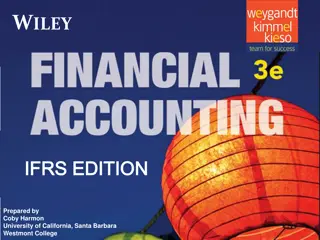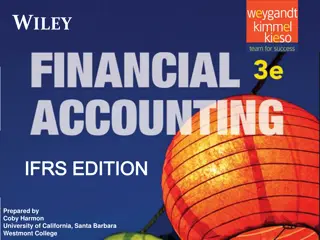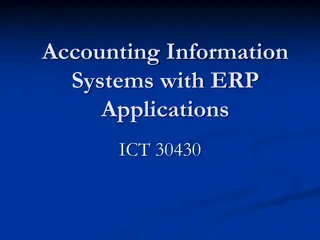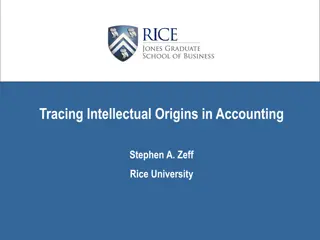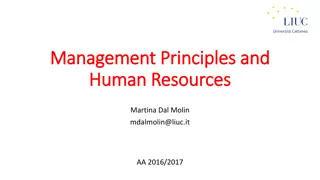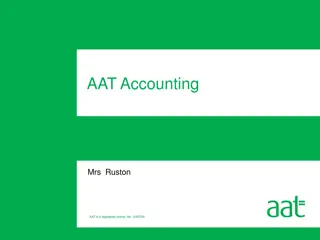International Financial Accounting & Policy: Worldwide Diversity
International accounting covers functional areas like financial accounting, management accounting, auditing, taxation, and accounting information systems. It explores three levels of standards – supranational, company-level, and country-level diversity, detailing reasons for accounting disparities such as legal systems, taxation variances, financing sources, inflation impact, and political/economic factors.
Download Presentation

Please find below an Image/Link to download the presentation.
The content on the website is provided AS IS for your information and personal use only. It may not be sold, licensed, or shared on other websites without obtaining consent from the author.If you encounter any issues during the download, it is possible that the publisher has removed the file from their server.
You are allowed to download the files provided on this website for personal or commercial use, subject to the condition that they are used lawfully. All files are the property of their respective owners.
The content on the website is provided AS IS for your information and personal use only. It may not be sold, licensed, or shared on other websites without obtaining consent from the author.
E N D
Presentation Transcript
PGDBFS 103 INTERNATIONAL FINANCIAL ACCOUNTING AND POLICY (IFAP) WORLDWIDE ACCOUNTING DIVERSITY AND CONVERGENCE
What is International Accounting? Accounting The word accountingin International accounting encompasses: Functional areas of financial accounting, management accounting, auditing, taxation and accounting information systems International The word international in International accounting can be defined at three levels: Supranational accounting standards, guidelines and rules of accounting, auditing and taxation issued by supranational organisations [e.g. United Nations, Organisation for Economic Corporation and Development (OECD)]. Company level standards, guidelines and practices that a company follows related to its international business and foreign investments (e.g. conversion of the results of foreign operations denominated in foreign currency). Country level and cross-country level study of standards, guidelines and rules of accounting, auditing and taxation that exist within each country and as well as comparison of those items across countries.
WORLDWIDE ACCOUNTING DIVERSITY Considerable differences exist across countries in the accounting treatment of many items. The lesser important differences relate to presentation of financial statements or terminology, whereas there are also more important difference that relate to recognition and measurement of assets /liabilities, income/expenses. Examples: In Maldives the Banks are required to account for its loan loss provision at the higher of; a time based (days in arrears of loans) provision calculated according to the rules laid down by the central bank, and the provision calculated purely based on IFRS principals. In India, IFRS 9 is not yet adopted for banking sector. Provisioning for credit risk is therefore based on rules laid down by Reserve Bank of India (RBI).
1. Reasons for accounting diversity (a) Legal system: There are two major types of legal systems in the world: Common law and codified Roman law. To a certain extent the accounting practices of a country could be seen as been affected by the legal system it adopts. Common law Code law/Roman law (b) Taxation i. In some countries published financial statements form the basis for taxation (eg. Germany), where as in other countries financial statements presented to shareholders are adjusted based on tax laws/principals for tax calculation purposes. ii. The differences in treating income and expenses for accounting and tax purposes give rise the Deferred taxes .
(c) Providers of financing Financing dominated by families Vs financing dominated by general public Financing dominated by Equity Vs financing dominated by Debt (d) Inflation Countries experiencing hyperinflation have found it necessary to adopt accounting rules that require inflation adjustment of historical costs. (e) Political and economic ties For example, countries colonies by British tend to follow British style of accounting while countries colonized by French tend to follow French type of accounting systems.
2. Problems caused by accounting diversity a) Preparation of consolidated financial statements b) Access to foreign capital markets c) Comparability of financial statements d) Lack of high-quality accounting information Harmonization Because of the problems caused by worldwide accounting diversity, attempts to reduce such differences have been ongoing for decades. This process in known as harmonization.
3. Accounting clusters Along with the world wide accounting diversity, there are clusters of countries that share common accounting orientation and practices. Example: The Anglo-Saxon / Anglo-American model: Continental European model: Inflation adjusted model: Nobes s Judgmental classification of financial reporting systems. Concentrating on the Anglo-Saxon and Continental European model countries, Nobes developed a develop a model that tries to explain how the financial reporting systems of 14 developed countries relate to one another.
Nobess Judgmental classification of financial reporting systems. Species Class Sub-class Family Government, economics Sweden Macro- uniform (Continental european) Japan Germany Law - based Continental: government, tax,legal Spain, Belgium, France, Italy Tax - based Developed western countries (14 countries used) US Business practice; pragmatic British origin Canada, USA influence Micro Based (Anglo- american) UK Ireland, UK, New Zealand, Australia influence Busines eonomics, accounting theory Netherlands
4. The influence of culture on financial reporting Hofstede s Cultural dimensions Individualism preference for a loosely knit society, compared to a closely knit society (collectivism). Power distance extent to which hierarchy an unequal power distribution in institutions are accepted. Uncertainty avoidance degree to which individuals feel uncomfortable with uncertainty and ambiguity. Masculinity emphasis on masculine values of performance and achievement, rather than feminine values of relationships, caring and nurturing. Long-term orientation fostering virtues oriented towards future rewards, in particular perseverance and thrift.
Garys accounting values 1. Professionalism Vs Statutory control 2. Uniformity versus Flexibility 3. Conservatism versus Optimism 4. Secrecy versus transparency Relationship between accounting values and cultural dimensions Accounting values Cultural dimensions Professionalism Uniformity Conservation Secrecy Power distance Neg Pos n/a Pos Uncertainty avoidance Neg Pos Pos Pos Individualism Pos Neg Neg Neg Masculinity Pos n/a Neg Neg Long term orientation Neg n/a Pos Pos
A simplified model International accounting diversity Nobes developed a simplified model limiting the reasoning for international accounting diversity to, culture and nature of financing system. Self sufficient : Type 2 culture Self sufficient : Type 1 culture Strong equity - outsider financing (large number of outside shareholders) Weak equity - outsider financing Class B accounting for tax and creditors Class A accounting for outside shareholders * Measurement practices are more conservative * Disclosure is not extensive * Accounting practice more closely follows tax rules * Similar to Continental European accounting. * Measurement practices are less conservative * Disclosure is extensive * Accounting practice differs from tax rules * Similar to Anglo-Saxon type accounting
5. Further evidence on accounting diversity I. Content of financial statements II. Format of the financial statements III.Level of detail IV. Terminology V. Disclosure VI. Recognition and measurement
INTERNATIONAL CONVERGENCE OF FINANCIAL REPORTING The accounting profession and standard setters have been under pressure to reduce diversity and harmonize accounting standards and practices internationally. International accounting standard setting 1950 -1960 s - rapid expansion of international trade, foreign direct investment and engagement in international transactions. This fueled the need to harmonize and standardize financial reporting. Harmonization: reduction of alternatives while retaining a high degree of flexibility in accounting practices. Standardization: elimination of alternatives in accounting for economic transactions and events.
Harmonization efforts Accounting harmonization can be considered in two ways: a) Harmonisation of accounting regulations. b) Harmonisation of accounting practices. Regionally and worldwide a several organisations were involved in the harmonization effort: a) International Organisation of Securities Commissions (IOSCO) b) International Federation of Accountants (IFAC) c) International Forum of Accountancy Development (IFAD) d) International Accounting Standards Committee (IASC) e) European Union (EU)
Arguments for and against international convergence of financial reporting standards Arguments for convergence a) To increase comparability of financial statements - globalization of capital markets. b) Makes it easier for investors to evaluate potential foreign investments. c) Simplify the evaluation of multinationals of possible foreign takeover targets. d) Reduce financial reporting costs of companies that seek to list on foreign stock exchanges. e) Facilitate cross listing of securities - to gain access to less expensive capital in other countries. f) National differences in corporate reporting cause loss of investor confidence. g) Investors premium on ROI if there is uncertainty or lack of comparability in figures. h) Reduce the cost of preparing financial statements and also would make auditing simplified. i) Would increase the mobility of accounting and auditing staff across countries. j) Raises the quality of accounting practices internationally.
Arguments for and against international convergence of financial reporting standards Arguments against convergence a) Magnitude of differences and the political cost of eliminating those would be enormous. b) Resistance of nationalist forces to bow down to international bodies. c) Difficulties in arriving at principals that satisfies all parties involved throughout the world. d) Its argued that well developed capital markets existed even without uniform accounting practices. e) Standard overload for small non-complex entities. f) Capital markets could require the few companies that benefit from cross-border financing to provide the required information /reconciliations, without needing all the companies to converge. g) Due to different environmental influences, differences in accounting across countries might be appropriate and necessary. (e.g. different stages in economic development, different sources of financing)
Convergence to IFRS Adoption of IFRS Vs convergence to IFRS Adoption of IFRS Implementation of IFRS in the same manner as issued by the IASB. Once adopted the country s accounting standards will be fully compliant with the guidelines issued by IASB. Convergence with IFRS - Accounting standard Board of the country applying IFRS would work with IASB to develop high quality comparable accounting standards over time. The countries converging to IFRS may deviate to a certain extent from IFRS s as issued by the IASB. Different strategies of convergence: a) Replace national GAAP with IFRS. b) Adopt IFRS as national GAAP on a standard-by-standard basis. c) Eliminate differences between National GAAP and IFRS.
Convergence to IFRS Different levels at which IFRS could be adopted a) All companies in effect IFRS replaces national GAAP. b) Parent companies in preparing consolidated financial statements separate / individual financial statements continue to be prepared under local GAAP. c) Stock exchange listed companies Non-listed entities use national GAAP. d) Foreign companies listed on domestic stock exchange. e) Domestic companies that are listed in foreign stock exchanges.
The IASB Framework Conceptual Framework for the preparation and presentation of financial statements Conceptual framework will increase public confidence in financial reports. Provides a platform for auditors to resolve an accounting issue in the absence of a standard that specifically deals with that issue. Contents of the Framework a) Objectives of the financial statement and underlying assumptions. i. Objective - provide information useful for decision making. ii. Assumptions Accrual basis, Going concern b) Qualitative characteristic of financial statements Understandability, Relevance, Reliability, Comparability c) Elements of financial statements Assets, Liabilities, Income, Expenses d) Concept of capital and capital maintenance
REVISED CONCEPTUAL FRAMEWORK FOR FINANCIAL REPORTING The revised Conceptual Framework now sets out a more complete set of concepts in eight chapters: Chapter 1 The objective of financial reporting Chapter 2 Qualitative characteristics of useful financial information Chapter 3 Financial statements and the reporting entity Chapter 4 The elements of financial statements Chapter 5 Recognition and derecognition Chapter 6 Measurement Chapter 7 Presentation and disclosure Chapter 8 Concepts of capital and capital maintenance New New 20
REVISED CONCEPTUAL FRAMEWORK FOR FINANCIAL REPORTING New Chapters Chapter 3 Financial statements and the reporting entity Reporting entity - An entity that is required, or chooses, to prepare financial statements Not necessarily a legal entity could be a portion of an entity or comprise more than one entity Financial statements A particular form of financial reports that provide information about the reporting entity s assets, liabilities, equity, income and expenses (Consolidated financial statements, 21 Unconsolidated financial statements, Combined financial statements)
REVISED CONCEPTUAL FRAMEWORK FOR FINANCIAL REPORTING New Chapters Chapter 7 Presentation and disclosure Concepts describing how information should be presented and disclosed in financial statements Guidance on classifying income and expenses for the Board to use when it decides whether they are to be included in or outside of the statement of profit or loss Guidance for the Board on whether and when income and expenses included in other comprehensive income (OCI) should subsequently be recycled to profit or loss 22
REVISED CONCEPTUAL FRAMEWORK FOR FINANCIAL REPORTING MAIN CHANGES New concepts on measurement, including factors to be considered when selecting a measurement basis Measurement concepts on presentation and disclosure, including when to classify income and expenses in other comprehensive income Presentation and disclosure guidance on when assets and liabilities are removed from financial statements Updated Derecognition Definitions definitions of an asset and a liability Recognition criteria for including assets and liabilities in financial statements Clarified 23 Measurement uncertainty Substance over form Prudence Stewardship
REVISED CONCEPTUAL FRAMEWORK FOR FINANCIAL REPORTING New Changes Measurement Historical cost measurement basis Current value measurement basis- fair value, value in use, fulfilment value and current cost Derecognition the removal of all or part of a recognised asset of liability from an entity s statement of financial position . It goes on to say that derecognition normally occurs: For an asset, when the entity loses control of all or part of the recognized asset For a liability, when the entity no longer has a present obligation for all or part of the recognised liability 24
REVISED CONCEPTUAL FRAMEWORK FOR FINANCIAL REPORTING What is updated ? Definition of a asset Previous definition A resource controlled by the entity as a result of past events and from which future economic benefits are expected to flow to the entity New definition A present economic resource controlled by the entity as a result of past events. An economic resource is a right that has the potential to produce economic benefits Definition of a liability Previous definition A present obligation of the entity arising from past events, the settlement of which is expected to result in an outflow from the entity of resources embodying economic benefits New definition A present obligation of the entity to transfer an economic resource as a result of past events. An obligation is a duty of responsibility that the entity has no practical ability to avoid 25
REVISED CONCEPTUAL FRAMEWORK FOR FINANCIAL REPORTING What is updated ? New recognition criteria Recognition is appropriate if it results in both relevant information about assets, liabilities, equity, income and expenses and a faithful representation of those items, because the aim is to provide information that is useful to investors, lenders and other creditors. Previous recognition criteria An entity should recognise an item that met the definition of an element if it was probable that economic benefits would flow to the entity and if the item had a cost or value that could be determined reliably. 26
REVISED CONCEPTUAL FRAMEWORK FOR FINANCIAL REPORTING Impact The Framework is not a IFRS standard. Therefore nothing will change in the short term. The revised Framework will be used in future standard-setting decisions, but no changes will be made to current IFRS. Preparers might also use the Framework to assist them in developing accounting policies where an issue is not addressed by an IFRS. 27
IFRS in the United States Rules based US GAAPs Vs Principal based IFRSs. Norwalk Agreement (2002) - FASB and IASB pledged to use their best efforts to make their existing financial reporting standards and work programs compatible. 2006-2008 financial crisis - pressure to FASB and IASB accommodate the interests of the Banking regulators in the standard setting process. In 2007 SEC remove the requirement that foreign private issuers using IFRS reconcile their financial statements to US GAAP. In 2009, FASB and IASB issued a joint statement detailing the status of the convergence process, and identified two particularly controversial topics: (1) Accounting for financial instruments and (2) De-recognition of assets and liabilities. In 2011, IASB and FASB competed the Fair Value Measurement project, and issued IFRS 13 and SFAS 257 respectively. In 2014, IASB chairman suggested that IASB would no longer seek full convergence with US GAAP.









